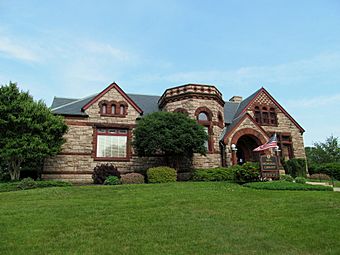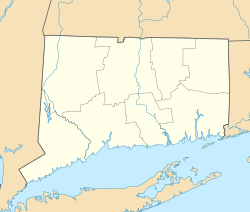Groton Bank Historic District facts for kids
Quick facts for kids |
|
|
Groton Bank Historic District
|
|

Bill Memorial Library, designed by Stephen C. Earle, is a contributing property in the district
|
|
| Location | Roughly bounded by the Thames River, Broad, Cottage, and Latham Streets, Groton, Connecticut |
|---|---|
| Area | 50 acres (20 ha) |
| Architect | Multiple |
| Architectural style | Mixed (more than 2 styles from different periods) |
| NRHP reference No. | 83001287 |
| Added to NRHP | March 24, 1983 |
The Groton Bank Historic District, also known as Groton Heights, is a special area in the City of Groton, Connecticut. It's mostly a neighborhood with homes and buildings that have a lot of history. This district covers about 50 acres (20 hectares) and was added to the National Register of Historic Places on March 24, 1983. This means it's a place recognized for its important history and architecture.
Contents
What Makes Groton Bank Special?
The Groton Bank Historic District has a unique shape, like an upside-down "U". This shape is formed by Thames, Broad, and Monument Streets. The district's boundaries were set using an old map from 1868. It includes an area that grew a lot between 1820 and 1860. During this time, Groton was a very busy place for whaling (hunting whales) and shipbuilding.
A Glimpse into Groton's Past
English settlers first came to Groton in the mid-1600s. However, not many buildings from that early time are still standing. This is because many were destroyed during the Battle of Groton Heights in the American Revolutionary War. This battle was a tough fight that happened in 1781. Even so, some houses built after the war in the late 1700s and early 1800s still exist. One example is the Major Noyes Barber house, built in 1810. It's a great example of the Federal architecture style, which was popular after America became independent.
Amazing Architecture in the District
The Groton Bank Historic District shows off many different building styles from its long history. It's like a timeline of architecture!
Notable Buildings and Their Styles
- Groton Heights Baptist Church: This church was built in 1878. It's a beautiful example of Italianate architecture. This style often features tall, narrow windows, wide overhanging roofs, and decorative brackets.
- Thomas Miner House: Located on Monument Street, this house was built around 1894. It shows the Queen Anne style of architecture. Queen Anne homes are known for their varied textures, turrets, towers, and decorative details.
- Commercial Buildings: Along Thames Street, you can see several commercial buildings from the late 1800s. These were once busy shops and businesses.
- Bill Memorial Library: This library is a standout building in the district. It was designed by Stephen C. Earle and is a fantastic example of Richardsonian Romanesque design. This style uses heavy stone, round arches, and often has a strong, castle-like feel.
The Groton Bank Historic District is a wonderful place to see how a town grew and changed over time, especially through its buildings.



